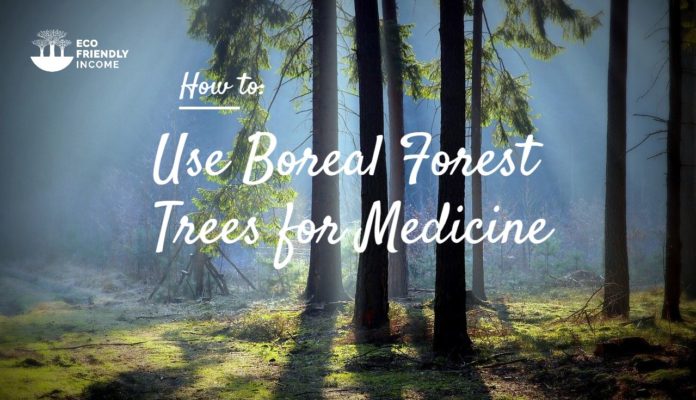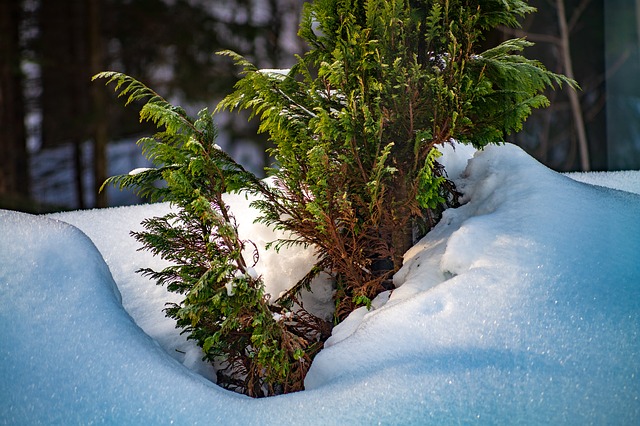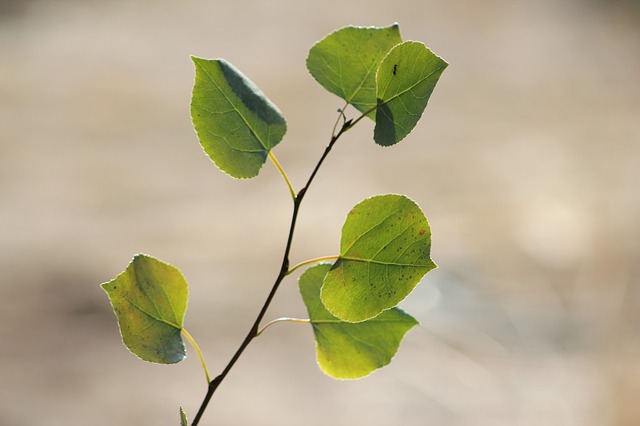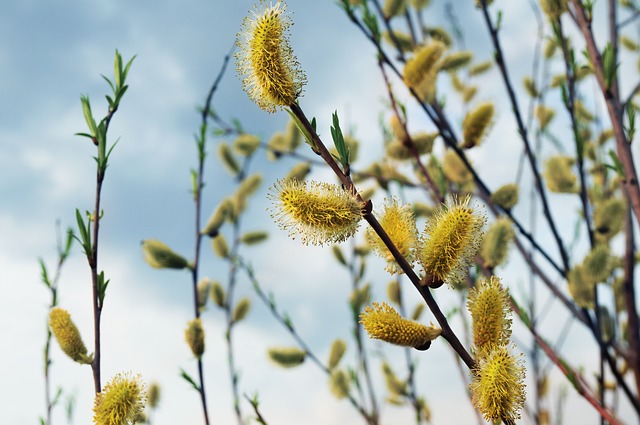The boreal forests of the world have some of the coldest temperatures found on the planet. Only the hardiest of humans have been able to inhabit these regions.
When conditions are this hard, naturally we use anything in the surroundings to adapt and survive. One of the most abundant resources, trees, happen to have many uses outside of building shelter.
The indigenous people of the regions quickly learned of the many medicinal uses of the boreal forest trees. The bark, leaves, branches, and roots were boiled and steeped into a tea to provide a source of comfort and relief. Such teas were used to treat common colds, respiratory problems, clean the system, and warm the soul.
According to the Cherokee, in the beginning, all creation spoke the same language. All existed in harmony, but the plants, animals, and the four elements knew that the two-legged ones (humans) would need help if they were to survive.
So a great accord was struck, humans were allowed to take from nature what they needed for food, clothing, and shelter with one condition: They would need to ask permission for these gifts, to give thanks, and to take no more than they needed. They respected this and so, it was good.
But then, the two-legged ones grew in numbers, and the mentality changed. They began to feel themselves as superior to the rest of creation, thinking that the great web of life revolves only around them. They had forgotten that they are just a small part of the great circle of life. The two-legged ones began to kill without asking for permission, to take more than they needed, and they ceased to give thanks. The great agreement was broken.
The great animal council banded together to decide on how to right these wrongs. Something needed to be done so that they may protect themselves from destruction and eradication. So it was decreed by the council that if one of their members was killed, without giving thanks, the Chief Animal Spirit would afflict the disrespectful killer with a terrible disease.
But not everyone agreed, the plants distressed and said to the animals:
“They dig us up, trample us, burn us and they don’t listen to the advice we have to give them. Yet we feel compassion for the two-legged, man struggles to realize his place in the great web of creation, and he cannot learn if he is wiped out by disease. Man needs our help and so for every disease you bring to them, we, the Plant People, will give them a cure. All that the two-legged have to do is to listen when we speak to them.”
What’s the moral of the story? Perhaps that humans have lost touch with reality over time, perhaps it’s that showing unconditional compassion is the true way of life.
It’s an interesting story that really does make you think, the Plant people have given us a cure for every disease, all we have to do is listen to them when they speak. They are speaking now and I am listening, let me share with you the secrets of the Tree People:
Boreal Forest Trees With Medicinal Properties
1. Black & White Spruce (Picea mariana & Picea glauca)
Identification:
Black Spruce (Picea mariana) is identifiable by its narrow peak, the trees often look irregular, forming periodic dense tufts. Black spruce bark is dark and scaly, the needles are short, growing only up to 1.5cm. The needles have more of a round shape, if you pluck one and pinch it between your thumb and index, you will be able to roll it.
The male cones, beige-brown, and the female cones, dark red-purple form on different branches. Black spruce is often found growing in poorly drained, organic soils, they tolerate shade.
White Spruce (Picea glauca) is identifiable by its pyramidal peak, unlike the black spruce, the growth pattern is regular and very triangular from top to bottom. The bark is scaly, and the male cones, yellowish-red often grow at the end of the branches, the reddish-purple female cones also grow on the same tree.
White spruce needles are slightly longer than black spruce needles, growing up to 2.5cm. Pinching them between your fingers, you can also roll them. White spruce grows in well-drained soils and tolerates shade.
Fun fact: Old Tjikko, a ~ 9550 year old Norway Spruce, is amongst the oldest trees in the world.
A Nordic tale says that to this day, a silver-haired, blue-eyed fairy still inhabits a spruce forest of the North. When the wind sweeps across the conifers, it’s her voice that sings the slow chant of winter or the dancing ballad of summer.
Medicinal Properties:
Spruce resin: Antimicrobial, anti-inflammatory, antiviral, bactericide, laxative.
- Spruce resin is antimicrobial against a wide range of bacteria and fungi; you can use it to dress wounds. (1)
- When chewed, mixed with saliva first, you can use spruce resin to keep the common cold and influenza away.
- Added to bath salts, spruce resin is a relaxant.
Native American medicinal uses of spruce:
- Sapwood for pain relief.
- Branches against cold and influenza.
- Spruce cones against coughs, irritated throats, diarrhea, scrofula, and to lower blood sugar levels.
- Resin mixed with animal grease to treat cuts, burns, mosquito bites, irritation, skin problems, and infections.
- A decoction from the branches treated arthritis, headaches, and stomach aches.
Spruce trees are emblematic medicinal trees of the boreal forest.
2. Eastern White Cedar (Thuja occidentalis)
Identification:
Northern White Cedar (Thuja occidentalis) is identifiable by its smooth bark, which comes off in strips. Thuja leaves and wood are very aromatic, leaves are quite unique, forming scale-like flat needles. The small greenish-yellow male cones, as well as the female light pink cones, appear across the ends of the branches. In nature, arborvitae often grows in swampy land with limestone rocks, peat bogs, and on top of rocks.
In my opinion, thuja trees are amongst the most beautiful boreal forest medicinal trees.
Fun fact: Did you know Eastern White Cedar is one of deer’s favorite foods?
Arborvitae is honored as a Grandmother Tree within Indigenous cultures throughout North America. Her gifts of wisdom and protection associate her with the north direction of the medicine wheel.
Medicinal Properties:
Antimicrobial, antioxidant, antiviral, anti-cancerous, immunostimulant, vermifuge, and hypotensor, insecticide.
In herbalism, thuja is used to treat cutaneous problems and warts.
Native American medicinal uses of thuja:
- Sapwood as a painkiller.
- Leaves for colds, influenza, coughs, fever, constipation, headaches, chronic pain, and scurvy.
- Leave decoction to treat ear and toothaches, colic, and kidney problems.
- Women used it as an adjuvant while giving birth or during difficult menstruations.
- Rotten thuja wood, reduced to powder is applied on the skin to treat itchiness and irritation.
3. Balsam Fir (Abies balsamea)
Identification:
Balsam Fir (Abies balsamea) is identifiable by pyramidal shape, it has a smooth dark gray bark riddled with resin bubbles. The easiest way to differentiate spruce from fir is the needles. Balsam fir needles are flat, you cannot roll it when you pinch it between your fingers. The previous year’s growth holds the round, yellow-colored male cones while the peak of the tree holds the purple-colored female cones.
Balsam fir grows in a large variety of soils, but preferably humid soils, and they support shade.
Druntia, the goddess of the fir, was honored as protectress and queen of druids. Balsam firs contain the energy of resistance and the light of hope, this is why on the winter solstice, we make Christmas trees out of them, the luminous symbol of generosity.
Medicinal Properties:
Anti-scurvy, antiseptic, antibiotic, laxative, diuretic, calming, antimicrobial, antiviral, anti-tumor.
Balsam fir resin is useful to clear respiratory airways, it’s used in syrup to treat colds, influenza, and to disinfect. It has properties that help the scaring mechanism in wounds and treats stomach ulcers and aches, along with indigestion and constipation. The resin is easily collected by piercing the bubbles found on the bark.
Native American medicinal use of Balsam fir:
- Resin salves to treat skin ulcers, burns, irritation, and bites.
- Tea from inner bark to lower blood sugar levels.
- Tea from young shoots, branches, and bark to treat chest pains, headaches, colds, and coughs.
- Resin applied on teeth to relieve aches.
- Herbal decoction for the bath or sweat lodge to relieve muscle spasms and joint pain.
4. Tamarack Larch (Larix laricina)
Identification:
Tamarack Larch (Larix laricina) is identifiable by its scaly gray bark with a tint of red. It grows a fairly straight trunk, the tree shape is conical in youth but grows to a more ovoid shape at its maturity. Larch needles are long and soft, they grow up to 6cm.
One of the special traits of this boreal forest medicinal tree is that during winter, tamarack larch will shed all of its needles. This is the only conifer that does that while remaining healthy. Male cones are round and yellow, they spread laterally throughout a branch, the reddish female cones grow from a separate branch.
As a tree planter, we always plant larch in poorly drained soil, as they will do fairly well there as compared to other trees. You can often find them growing in bogs and near streams.
The word Tamarack comes from the Algonquin language, meaning wood used for snowshoes.
Medicinal Properties:
Antimicrobial, astringent, expectorant, disinfectant, laxative, diuretic, tonic.
While Tamarack Larch has uses to fight colds, influenza, stomach ulcers, and jaundice. Like other conifers, larch inner bark has the ability to draw out infections and treat burns.
Native American medicinal use of Larch:
- Powdered bark was used to help heal wounds that had difficulty healing.
- A tea from the inner bark to lower blood sugar levels (treat diabetes).
- A light decoction of needles and fresh shoots were used in sweat lodges to stimulate the body.
- Tea was made from the inner bark and leaves to treat sore throat, bleeding gums, and coughs.
5. Paper Birch (Betula papyrifera)
Identification:
Paper Birch (Betula papyrifera) is identifiable by its white bark marked by beige horizontal streaks, which often peals back on itself and naturally sheds. Young birch twigs have a reddish color and grow alternate oval leaves with a sharp tip. Male catkins grow in bundles of 2 to 3 while female catkins are solitary, they all fall off during winter.
Paper birch grows in full sun, usually in well-drained soils. Chaga, a highly medicinal mushroom can be found growing on paper birch.
Foraging materials off deciduous trees like birch should be done carefully in order to prevent major damage to the tree.
According to Ojibwe legend, heroic figure Winabojo sought refuge in a hollow fallen birch tree while being pursued by a group of powerful and dangerous thunderbirds.
Medicinal Properties:
Astringent, diuretic, diaphoretic, anti-inflammatory, antimicrobial, anti-cancerous (betulinic acid).
The cambium of paper birch has a strong smell and taste of wintergreen, similar to gaultheria procumbens, if you have ever tried it, it’s great to flavor tea or in deserts as syrup.
In phytotherapy, this boreal forest medicinal tree is harvested in many ways:
- The sap is harvested at the beginning of spring.
- Leaves from June to September.
- Buds and bark in spring
Native American Medicinal use of Paper Birch:
- Decayed birch wood, combined with labrador tea was powdered and use liked baby powder to prevent irritation.
- Sapwood to treat headaches, to reduce abundant menstruations, to eliminate toxins, treat diarrhea, thicken blood, and help stop bleeding by inducing coagulation.
6. Trembling Aspen (Populus tremuloides)
Identification:
Trembling Aspen (Populus tremuoides) is recognizable by its straight trunk and its smooth, light green bark. The base of the trembling aspen trunks is often covered in gray crests.
Aspen leaves are somewhat heart-shaped, they have rounded teeth and a short tip at the end. Male and female catkins appear on different trees. Trembling aspen buds and seeds appear and are dispersed before the appearance of leaves.
Quaking aspen loves sunlight, it often grows in well-drained, clayey soils.
Aspens are special because their leaves constantly shake, even when there appears to be no wind.
According to Ute legend, the reason for this unique aspect of the aspen tree happened during a visit to Erath from the Great Spirit during a special full moon. All of nature anticipated the Spirit’s arrival and trembled to pay homage. All except the proud and beautiful aspen. The aspens stood still, refusing to pay proper respect. The Great Spirit was furious and decreed that, from that time on, the aspen leaves would tremble whenever anyone looked upon them.
Medicinal Properties:
Antimicrobial, antioxidant, anti-anxiety, pain reliever.
Aspen has useful properties to treat joint pain, prostate discomfort, back trouble, nerve pain, and bladder problems.
Native American Medicinal use of Trembling Aspen:
- The bark was boiled and made into cough syrup.
- The root was eaten to prevent premature childbirth and as a heart medicine.
- Boiled buds mixed with animal fat for a sore nose from colds.
- Root applied to burns and skin infections.
7. Balsam Poplar (Populus balsamifera)
Identification:
Balsam Poplar (Populus balsamifera) is often mixed up with trembling aspen due to its close resemblance, but upon closer inspection, there are many differences. Balsam poplar can be identified by its strong branches, greenish-brown bark that turns gray with age, and dark diamonds crest at the base of the trunk.
Poplar leaves grow alternatively, they have an oval shape and have rounded teeth. The leaves have a shiny coating and the underside is often covered in brown patches. You might remember grabbing ahold of poplar burgeons because they are very sticky.
The catkins are fluffy and on windy days will fly around everywhere, it’s happened to us on a few occasions where we hadn’t closed the garage door, and lo and behold, the garage had been filled with the fluffy seeds.
Balsam poplars grow in rich, humid soils.
The balm of Gilead, which has old testament origins, was made from balsam poplar resin. Merchants traveled to the mountainous regions of Gilead, to buy the balm or basalm.
Medicinal Properties:
Fungicide, anti-inflammatory, antibacterial, scarring, expectorant, antiseptic.
The vitamin-rich new growths (buds), can be swallowed raw(without chewing) to keep influenza and colds away. If you chew on them, they’ll put your tongue to sleep.
Poplar resin, added to ointment, hydrates, and relieves eczema.
Native American Medicinal use of Balsam Poplar:
- Ointments made from bear fat and poplar buds to treat earaches, sprains, and swellings.
- Resin from the buds to make cough medicine and treat sore throat.
8. Peachleaf Willow (Salix amygdaloides)
Identification:
Peachleaf Willow (Salix amygdaloides) is identifiable by the way its branch droop down and by the trunks, which almost always grow out in clumps. Willow leaves are long, elliptical, and narrow, they have a shiny coat and grow alternatively.
Male and female willow catkins appear on different trees, the males are puffier and shorter while the females are longer and narrower.
They are found growing near river beds, in full to partial sun, preferably on loamy, or silty soils.
Native Americans tied willow branches to their boats to protect them from storms and to their lodges for the protection of the Great Spirit.
Medicinal Properties:
Febrifuge, pain reliever, antidiarrheal, hemostat, dermatological aid.
Did you know aspirin is made from a medicinal extract from the willow tree? Salicin or salicylic acid contained inside willow bark is what gives the pain-relieving qualities of aspirin.
Native American Medicinal use of Willow:
- The inner layer of bark, cambium, was steeped in a tea and drank to relieve pain.
- Willow galls to treat spasmodic colic, dysentery, and diarrhea.
- Crushed fresh root to treat internal hemorrhages, throat constrictions, swollen neck glands, bloodshot or irritated eyes
- Twigs chewed to clean the teeth and to harden the gums in cases of pyorrhoea.
Bonus: Chaga (Inonotus obliquus)
Identification:
Chaga (Inonotus obliquus) is a fungus that grows only on birch trees. It looks like a black mass on the tree, it’s quite solid and if you break a piece off, the interior ranges from a yellow to brown color.
Chaga’s favorite host is paper birch and is found growing most often in the colder climates, especially the boreal forest range.
It’s basically a parasitical fungus that drains the minerals from the birch tree until it dies. For this reason, I only recommend harvesting Chaga from a live birch tree to ensure you get the highest quality fungus. It’s also a good idea to bring a sturdy tool when Chaga hunting because they have a firm hold to the tree.
One origin story for Chaga is that the Wisakecak, a mythological being, threw a scab mistaken for a piece of dried meat against a birch tree. According to their mythology, he was the first Chaga mushroom.
Medicinal Uses:
Chaga mushrooms have an extensive range of medicinal properties, you can almost call it the holy grail of medicinal fungus.
Within all medicinal mushrooms, Chaga contains one of the highest amounts of nutrients, minerals, vitamins, and antioxidants. It’s been used for centuries by many civilizations around the world and in modern-day is getting plenty of attention in pharmaceuticals.
Scientific research has isolated each effect to its source and found the following medicinal properties from Chaga:
- Sugars and carbohydrates: Contain chitin, lignin, cellulose beta glucose. These modulate the immune system, reduce allergies, psoriasis, and stress. It balances sugar levels and blood cholesterol.
- Phytosterols: Ianosterol, inotodiols, ergosterols, fecosterols, others. These are powerful therapeutics with antiviral and anticancerous properties, inotodiol is anti-mutagenic.
- Sterols: Betuline and betulinic acid: These are also antiviral and anti-cancerous, they stop the protein synthesis in tumor cells. These are particularly useful against stomach, colon, and liver cancer, and also reduce cholesterol levels.
- Antioxidants: Polyphenols, phenols, melanins: they limit the nasty oxidation processes within cells. Enzymes: Destroys free radicals that accumulate as we get old, these free radicals cause problems like inflammatory diseases like arthritis, neurodegeneratives, cardiovascularies, auto-immunes, and cataracts. The phenols and enzymes also have anti-aging properties if applied on the skin as a balm (mixed with honeywax or essential oils). Melanin is useful to treat skin inflammation like psoriasis and eczema.
- Vitamins: B2, B3, b5, D, and K
- Minerals: In form of salts, Chaga contains silicium, copper, iron, aluminum, manganese, magnesium, sodium, zin, potassium.
Not all of these can be extracted by steeping Chaga in hot water, some have to be extracted in alcohol.
- Water soluble: Sugars, some antioxidants, vitamin B groups, and minerals.
- Alcohol soluble: Lipids, some antioxidants, vitamins D and K
The source of the information regarding Chaga mushroom comes from a book by Roger Larivere: Plantes comestibles et medicinales de la foret boreal.
Native American Medicinal use of Chaga:
Tea was made by simmering Chaga for hours to make a stimulating drink that treated all sorts of viral related conditions.
Conclusion
The 8 boreal forest medicinal trees that were most commonly used by Native Americans.
- Spruce
- Eastern White Cedar
- Balsam Fir
- Tamarack Larch
- Paper Birch
- Trembling Aspen
- Balsam Poplar
- Peachleaf Willow
Bonus: Chaga
The great Cherokee story of compassion is beautiful, it pressed me to open my heart, to listen to the lessons of the Plant People… and I can say…. it’s been enlightening.
Now I ask you, join me in opening your heart! Listen to what the Plant People have to say. Now would be a good time to take a step back and learn about our roots, what do you think?
Disclaimer
If you take any of the medicinal trees below, please take them at your own discretion. If you have specific medical conditions, please consult with a doctor first to ensure it’s safe for you to take any of these medicinal trees. I do not take responsibility for any side effects that might occur when you ingest any of the trees below.
The thing with natural medicinal products is that they are hard to dose, it takes experience or the reference from a knowledgeable healer or elder. You should try in small doses first, then adjust to how you react to them.
All in all, these trees are safe to ingest and have been ingested for thousands of years, Chaga is also listed by the Canadian government as safe to ingest.





























